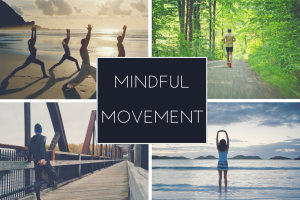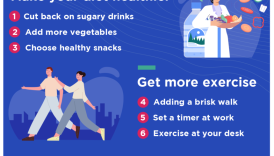Mindful Movement: A Pillar of Healthy Living

Mindful movement is more than just a trend; it’s a holistic approach to enhancing overall well-being through intentional physical activity. Imagine going for a walk and feeling each step resonate in your body, or practicing yoga while truly connecting with your breath. This practice blends mindfulness and movement in a way that can profoundly impact both your physical and mental health.
- Mindful Movement: A Pillar of Healthy Living
- What to Expect
- The Benefits of Mindful Movement
- Physical Health
- Mental Well-being
- Key Principles of Mindful Movement
- Breath Awareness
- Body Awareness
- How to Incorporate Mindful Movement Into Daily Routine
- Yoga Practice
- Walking Meditation
- Mindful Movement for Stress Relief
- Techniques to Reduce Stress
- Mindful Stretching
- Mindful Movement and Improved Sleep Quality
- Benefits of Mindful Movement for Sleep
- Mindful Movement for Enhanced Focus and Concentration
- Benefits of Mindful Movement for Focus
- Mindful Movement for Emotional Regulation
- How Mindful Movement Aids Emotional Regulation
- Mindful Movement for Increased Energy Levels
- How Mindful Movement Boosts Energy
- Mindful Movement Practices for Different Age Groups
- Tailored Practices for Different Ages
- Mindful Movement and Its Impact on Physical Fitness
- Benefits for Physical Fitness
- XII. The Connection Between Mindful Movement and Mindfulness Meditation
- How They Complement Each Other
- XIII. Mindful Movement as a Form of Self-Care
- The Benefits of Mindful Movement for Self-Care
- XIV. Mindful Movement in the Workplace
- Benefits of Mindful Movement at Work
- XV. Conclusion
- Key Takeaways
What to Expect
As we dive into the benefits of mindful movement, consider the following aspects:
- Physical Health: Discover how being aware during movement can lead to better physical conditions.
- Mental Well-being: Learn about the positive effects on stress reduction and emotional balance.
By embracing mindful movement, one can cultivate a deeper awareness of their body and mind, ultimately leading to a more fulfilling life.
The Benefits of Mindful Movement
The practice of mindful movement offers a treasure trove of benefits that can transform both physical health and mental well-being.
Physical Health
When individuals engage in mindful movement, they not only enhance their flexibility and strength but also promote overall physical wellness. This practice encourages:
- Improved Posture: Awareness of body alignment reduces strain and injuries.
- Increased Flexibility: Gentle movements allow for the gradual stretching of muscles and tendons.
- Enhanced Coordination: Mindful engagement helps sharpen balance and coordination skills.
For example, during a yoga session, focusing on each posture can lead to greater physical awareness, helping practitioners avoid injuries in daily activities.
Mental Well-being
Just as mindful movement benefits the body, it also nurtures the mind. Participants often experience:
- Reduced Anxiety: Concentrating on breath and movement calms the nervous system.
- Increased Mindfulness: The practice promotes a state of presence, helping alleviate distractions.
- Boosted Mood: Physical activity releases endorphins, which can lead to feelings of happiness and contentment.
Think of a time you took a stroll and noticed the beauty around you—the colors of the leaves, the scent of the air. This simple act of being present can significantly enhance mental clarity and mood, illustrating just how potent mindful movement can be.
Key Principles of Mindful Movement
To truly harness the benefits of mindful movement, it’s essential to focus on a few key principles. Two of the most important are breath awareness and body awareness.
Breath Awareness
Our breath serves as a vital anchor in mindful movement. Being aware of how we breathe can transform our entire practice.
- Focusing on each inhale and exhale helps ground the mind, drawing attention away from distractions.
- Controlled breathing can reduce stress and enhance relaxation during movement.
For instance, many practitioners find that synchronizing their breath with each yoga pose deepens their experience, adding a soothing rhythm to the flow.
Body Awareness
Equally important is understanding one’s body during movement.
- Identifying tension in various muscle groups allows individuals to adjust their practice accordingly.
- Connecting movement with sensation enhances overall physical awareness.
When engaged in mindful walking, paying attention to how each foot makes contact with the ground can foster a deeper connection to the surrounding environment. This heightened awareness can lead to not just better movement but also a greater understanding of one’s physical capabilities.
How to Incorporate Mindful Movement Into Daily Routine
Integrating mindful movement into your daily life doesn’t have to be a daunting task. In fact, there are simple yet effective ways to weave this practice into your routine, enhancing both physical and mental well-being.
Yoga Practice
Yoga is a fantastic entry point for mindful movement.
- Set aside a few minutes daily to focus on specific poses aligned with your breath.
- Try different styles—from gentle Hatha to energetic Vinyasa—to find what resonates with you.
A personal favorite is dedicating Sunday mornings to a restorative yoga session, allowing for reflection and rejuvenation.
Walking Meditation
Walking meditation is another accessible practice.
- Find a quiet space in your neighborhood or a local park.
- Focus on each step, feeling the ground beneath your feet and the rhythm of your breath.
For example, many people find walking home from work as an opportunity for mindfulness. Instead of rushing, they embrace the experience, connecting with their surroundings and slowing down the pace of their day. This simple adjustment can turn a mundane walk into a meaningful practice.
Mindful Movement for Stress Relief
Amid the hustle and bustle of daily life, mindful movement serves as an excellent solution for stress relief. By incorporating specific techniques, individuals can effectively manage stress through intentional movement and awareness.
Techniques to Reduce Stress
Several techniques form the foundation of mindful movement for stress relief:
- Deep Breathing: Start with a few deep breaths to calm the body.
- Progressive Muscle Relaxation: Gradually tense and then release each muscle group, promoting relaxation.
- Mindful Visualization: Picture a peaceful scene while engaging in gentle movement, enhancing tranquility.
A personal favorite is finding a quiet space, closing my eyes, and visualizing serene landscapes while breathing deeply, allowing stress to melt away.
Mindful Stretching
Mindful stretching also plays a significant role in reducing tension.
- Target tense areas: Focus on specific muscle groups that may hold stress, like shoulders or hips.
- Combine stretches with breath: Inhale deeply as you extend and exhale as you release.
For instance, dedicating a few minutes each morning to stretch while consciously breathing can set a stress-free tone for the day. By paying attention to how the body feels during each stretch, individuals can foster a greater sense of calm and body awareness, effectively combating stress.
Mindful Movement and Improved Sleep Quality
Just as mindful movement can relieve stress, it can also significantly enhance sleep quality. Engaging in conscious physical activity promotes relaxation and prepares both the body and mind for a peaceful night’s rest.
Benefits of Mindful Movement for Sleep
Incorporating mindful movement into your evening routine can yield several benefits:
- Reduces Restlessness: Gentle stretching or yoga before bed can help release accumulated tension.
- Calms the Mind: Breathing exercises enable the mind to switch off from daily worries, inviting tranquility.
- Establishes a Sleep Ritual: Consistency in practice can signal to your body that it’s time to wind down.
For example, after a long day, I often find solace in a 10-minute gentle yoga flow. This simple practice not only eases physical discomfort but also quiets my thoughts, making it easier to drift off to sleep. Incorporating mindful movement into your evening can lay the groundwork for improved sleep quality and a more restful night.
Mindful Movement for Enhanced Focus and Concentration
Building on the benefits of improved sleep quality, incorporating mindful movement into your day can also lead to enhanced focus and concentration. In a world filled with distractions, being deliberate about your movements can sharpen mental clarity.
Benefits of Mindful Movement for Focus
Engaging in mindful movement acts as a reset for your brain, providing various benefits:
- Increased Blood Flow: Movement stimulates circulation, delivering more oxygen to the brain.
- Improved Mental Clarity: Focusing on body movements can clear mental cobwebs and improve cognitive function.
- Stress Reduction: Lowering stress levels through mindful practices promotes a more conducive environment for concentration.
Personally, I’ve found that taking a brief mindful walking break while studying significantly boosts my focus. The combination of fresh air and deliberate movement helps clear my mind, allowing me to return to my tasks with renewed energy and clarity. By making mindful movement a priority, anyone can enhance their focus and concentration effectively.
Mindful Movement for Emotional Regulation
Transitioning from the benefits of enhancing focus, mindful movement also plays a crucial role in emotional regulation. By cultivating awareness of both body and mind, individuals can better manage their feelings and responses.
How Mindful Movement Aids Emotional Regulation
Incorporating mindful movement into your routine can provide several emotional benefits:
- Heightened Awareness: Understanding your physical sensations helps recognize emotional triggers.
- Release of Built-Up Tension: Physical activity allows for the expression and release of pent-up emotions.
- Promotion of Positive Emotions: Engaging in movement fosters the release of endorphins, elevating mood.
I often use mindful stretching when I’m feeling overwhelmed, focusing on areas where I feel tightness. This simple act not only eases my physical discomfort but also creates space to process any frustrating emotions. By consciously moving through feelings, anyone can harness the power of mindful movement to achieve better emotional balance and resilience.
Mindful Movement for Increased Energy Levels
Building on the importance of emotional regulation, mindful movement is also a powerful tool for boosting energy levels. In a fast-paced world, it’s common to feel drained, but engaging in intentional movement can refresh both body and mind.
How Mindful Movement Boosts Energy
Here are a few ways that incorporating mindful movement can elevate your energy:
- Stimulated Circulation: Movement gets your blood flowing, which can invigorate the body and reduce fatigue.
- Mental Clarity: Taking a break to move can refresh your perspective, making tasks seem more achievable.
- Mood Lifting: Engaging in physical activity releases endorphins, helping to lift your spirits and energy.
Personally, I find that taking a quick 5-minute dance break during a long work session revitalizes my energy. The combination of movement and music lifts my mood, making me feel more alert and ready to tackle the next task. By prioritizing mindful movement, anyone can experience a noticeable boost in their energy levels throughout the day.
Mindful Movement Practices for Different Age Groups
Continuing from the benefits of mindful movement in enhancing energy levels, it’s essential to recognize that these practices can be tailored to suit various age groups. Each stage of life brings unique needs and abilities, making mindful movement accessible for everyone.
Tailored Practices for Different Ages
Here are some mindful movement practices a range of age groups can embrace:
- Children: Encourage playful activities such as yoga games or nature walks to develop awareness and balance.
- Teenagers: Integrating activities like dance or team sports can foster mindfulness while enhancing coordination and self-esteem.
- Adults: Incorporate yoga or tai chi into daily routines for stress management and physical fitness.
- Seniors: Practices like gentle stretching or chair yoga promote flexibility and mobility, ensuring safety while maintaining health.
For instance, my neighbor hosts a weekly yoga class for seniors, where gentle movements and breath awareness foster a sense of community and well-being. No matter the age, mindful movement can enrich lives, offering physical and mental benefits tailored to current needs.
Mindful Movement and Its Impact on Physical Fitness
Shifting focus to mindful movement’s role in enhancing physical fitness, it’s essential to understand its multifaceted benefits. By merging awareness with physical activity, individuals can significantly improve their fitness levels while cultivating a positive relationship with their bodies.
Benefits for Physical Fitness
Mindful movement contributes to physical fitness in several impactful ways:
- Increased Flexibility: Regular practice of activities like yoga or Pilates enhances flexibility and range of motion.
- Strength Improvement: Engaging in mindful body movements helps build muscle strength through controlled exercises.
- Endurance: Mindfulness can help individuals push through physical barriers, enhancing stamina over time.
For instance, during my regular yoga sessions, I’ve noticed significant improvements in my muscle tone and flexibility, making everyday tasks feel easier. By incorporating mindful movement into fitness routines, practitioners can achieve their fitness goals while maintaining mindfulness and body awareness, turning workouts into holistic experiences for both the mind and body.
XII. The Connection Between Mindful Movement and Mindfulness Meditation
As we explore the impact of mindful movement on physical fitness, it’s essential to recognize its profound connection with mindfulness meditation. Both practices cultivate awareness and presence, enhancing overall well-being.
How They Complement Each Other
Mindful movement and mindfulness meditation share key principles and benefits:
- Presence: Both practices encourage being fully present in the moment, reducing distractions and promoting mental clarity.
- Bodily Awareness: Mindfulness meditation fosters a deeper understanding of bodily sensations, which enhances the effectiveness of mindful movement.
- Stress Reduction: Engaging in either practice can lower stress and anxiety, creating a sense of calm.
I often find that after a session of mindful movement, my mind is more receptive to meditation. This combination deepens my relaxation and enhances the benefits of both practices. By integrating mindful movement with mindfulness meditation, individuals can enjoy a holistic approach to mental and physical health that is both transformative and enriching.
XIII. Mindful Movement as a Form of Self-Care
Transitioning from the relationship between mindful movement and mindfulness meditation, it’s important to highlight how mindful movement serves as a powerful form of self-care. In a world often filled with demands and distractions, prioritizing this practice can tremendously enhance personal well-being.
The Benefits of Mindful Movement for Self-Care
Engaging in mindful movement offers a variety of self-care benefits:
- Recharge Energy Levels: Regular movement refreshes both the body and mind, combating fatigue.
- Enhance Emotional well-being: It cultivates a sense of overall contentment and helps manage emotions effectively.
- Promote Connection: Practicing mindful movement can deepen your connection to yourself, fostering self-acceptance.
For example, I’ve found that dedicating even 10 minutes a day to stretches and awareness exercises can transform my mood and mindset. These moments serve as mini-retreats, reminding me to listen to my body and address my needs. By embracing mindful movement as a form of self-care, individuals can build resilience and nurture their overall health in a meaningful way.
XIV. Mindful Movement in the Workplace
Building on the benefits of mindful movement as a form of self-care, it is equally vital to explore its implementation in the workplace. Many professionals experience stress and physical discomfort due to long hours sitting at desks. Incorporating mindful movement can significantly enhance productivity and overall well-being.
Benefits of Mindful Movement at Work
Integrating mindful movement into the workplace provides several advantages:
- Reduced Stress: Short breaks for stretching or breathing exercises can alleviate tension and refresh the mind.
- Increased Focus: Engaging in mindful movements clears mental fog, improving concentration on tasks.
- Enhanced Collaboration: Group movement activities foster teamwork and improve workplace relationships.
For instance, at my last job, we implemented a weekly “movement break” where we practiced simple stretches together. Not only did this boost our energy, but it created a sense of community among colleagues. By prioritizing mindful movement in the workplace, organizations can cultivate a healthier, more engaged workforce that thrives in their roles.
XV. Conclusion
In conclusion, the integration of mindful movement into daily life holds immense potential for enhancing physical health, emotional well-being, and overall quality of life. As we’ve explored throughout this discussion, mindful movement serves as a multifaceted approach that fosters awareness, reduces stress, and promotes self-care.
Key Takeaways
Here are some essential points to remember:
- Flexibility & Strength: Mindful movement can improve both physical fitness and emotional resilience.
- Workplace Benefits: Incorporating mindful practices at work enhances productivity and well-being.
- Personal Connection: Engaging in these activities fosters a deeper connection to oneself and the surrounding environment.
Reflecting on my own experience, I’ve found that even small sessions of mindful movement can create profound shifts in mood and energy. By embracing these practices, anyone can cultivate a healthier relationship with their body, mind, and spirit, leading to a more rewarding life journey.





